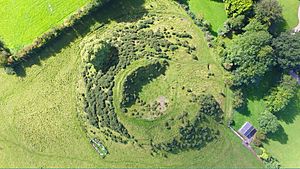Dowth facts for kids

Aerial view of Dowth
|
|
| Location | valley of the River Boyne |
|---|---|
| Region | County Meath, Ireland |
| Coordinates | 53°42′13″N 6°27′01″W / 53.70365°N 6.4502°W |
| Type | passage grave |
| Part of | Brú na Bóinne |
| History | |
| Periods | Neolithic |
| Type | Cultural |
| Criteria | i, iii, iv |
| Designated | 1993 (17th session) |
| Part of | Brú na Bóinne - Archaeological Ensemble of the Bend of the Boyne |
| Reference no. | 659 |
| Ireland | |
| Region | Europe and North America |
| Official name | Dowth Mound & Dowth Passage Tomb |
| Reference no. | 410 & 652 |
Dowth (Irish: Dubhadh) is an ancient burial place called a Neolithic passage tomb. It is found in the Boyne Valley, in County Meath, Ireland. It is one of the three main tombs of the Brú na Bóinne World Heritage Site. This site is a special area with many old monuments. The other two big tombs are Newgrange and Knowth.
Dowth is very old, built between about 3200 and 2900 BC. That means it's over 5,000 years old! It is not as famous as Newgrange or Knowth. This is partly because its inside chamber is lower. Also, its decorations are harder to see. People have explored Dowth for a long time. Early explorers in 1847 caused some damage to the roof. But even before that, people like the Vikings had entered the tomb. In 2018, another passage tomb was found nearby. It had rock art similar to Dowth's.
Contents
What Dowth Looks Like
The main part of Dowth is a large mound of earth and stones. This type of mound is called a cairn or tumulus. It is about 85 meters (279 feet) wide. It stands about 15 meters (49 feet) high. Large stones, called kerbstones, surround the mound. Some of these stones have carvings on them.
Shiny white quartz stones were found outside the kerbstones. This suggests the entrance once glittered white, just like at Newgrange. There are three stone-lined paths that go into the mound from the west. Two of these are passage tombs. They are known as Dowth North and Dowth South. The third path is a later addition called a souterrain.
Dowth North Tomb
The longest path is Dowth North. It is 18.2 meters (60 feet) long. It has three sill-stones on the floor. The path leads to a chamber shaped like a cross. This is called a cruciform chamber. Its roof is made of flat stones, not a dome shape like Newgrange.
Many of the upright stones, called orthostats, in the passage and chamber have carvings. These carvings include spirals, zigzags, diamond shapes, and circles with rays. On the floor of the chamber, there is a large stone basin. It measures 1.4 meters by 1 meter (4.6 by 3.3 feet).
One arm of the cross-shaped chamber leads to another long room. This room has an L-shaped part. It is sometimes called 'the annex'. This annex might be the oldest part of the tomb. It has a large flagstone on its floor. This stone has an oval hollow, called a bullaun.
Dowth South Tomb
A special kerbstone marks the entrance to Dowth South. It has cup-marks, a spiral, and a flower-like design. This tomb is 3.5 meters (11.5 feet) long. It ends in a round chamber. The current roof is made of concrete. The original roof might have been dome-shaped, like at Newgrange. This tomb also has a few decorated stones. It has a large space on its right side.
The Souterrain
The third entrance on the west side of Dowth is a souterrain. This is an underground passage from early Christian times. It was built around the 10th or 11th century CE. This souterrain leads into the passage of Dowth North. Old records say that Vikings raided a "cave" at Dowth around 862 CE. This "cave" might have been the souterrain.
There were originally about 115 kerbstones around the mound. Kerbstone 51 is very special. It is sometimes called the Stone of the Seven Suns. It has many circular carvings with rays. These are similar to carvings found at another ancient site called Loughcrew.
Sunlight and Dowth
Dowth has a special connection with the sun during the winter solstice. This is the shortest day of the year. Martin Brennan, a researcher, found this amazing alignment. He studied the Boyne Valley for ten years.
From November to February, the rays of the evening sun shine into Dowth South. They go into its passage and then into the chamber. During the winter solstice, the sun's light moves along the left side of the passage. Then it enters the round chamber. Here, three stones are lit up by the sun.
A curved stone in the middle reflects the sunlight. It sends the light into a dark space. This lights up the decorated stones there. After about two hours, the sun's rays slowly move back. They go along the right side of the passage. Then the sun leaves Dowth South.
Images for kids
See also
 In Spanish: Dowth para niños
In Spanish: Dowth para niños





